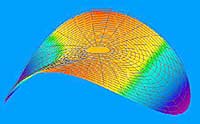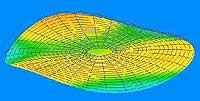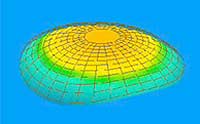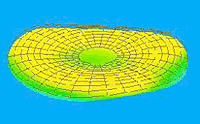Wavefront analysis moves beyond refractive surgery
The WASCA analyzer can evaluate IOL function and may make dynamic measurement of accommodation possible.
ANTWERP, Belgium — Refractive surgery remains the main application for wavefront technology. However, one company is focusing on applying the technology to a broader range of ophthalmic applications.
|
|
Frank Goes, MD, a refractive and cataract surgeon here, said the Wavefront Aberration Supported Corneal Ablation (WASCA) wavefront analyzer from Asclepion-Meditec AG can be used for a variety of applications. “You can use it to check on all kinds of IOLs. You can check on patients who have had RK or holmium LTK treatments,” he said. “You can use it for cataract surgery, and get some very interesting pictures. You can also use it as an autorefractor.”
Dr. Goes said the WASCA analyzer produces an accurate representation of the quality of the lens and that it could possibly be used to measure posterior capsular opacification. “It has not yet been done, but each time that they touch on this thing, they find new applications,” he said. “Probably, in the future, it may be a tool for the general ophthalmologist.”
Dr. Goes uses the WASCA analyzer in his own practice for refractive surgical applications. “We are measuring each eye, and when there are higher-order aberrations, we apply wavefront-guided treatments,” he said. “So we do a selection, and I’d say that 20% to 25% have wavefront-guided treatments. In the future, probably each patient will have wavefront-guided treatment.”
He noted that achieving “super-vision” after refractive surgery is an unreasonable expectation. “Only a minority of patients will gain in their acuity number. Some patients will get higher acuity. But that’s also not the goal of the treatment. The goal is to improve on the optical quality of their vision.”
“No company is talking anymore about eagles’ eyes and creating super-normal eyes. They are talking about quality of vision and things like that. We should not create unrealistic expectations,” he said.
Dr. Goes said he is involved in studies with Prof. Ioannis G. Pallikaris, MD, doing dynamic wavefront accommodation measurements.
“It is the only objective way to measure it,” he said. “It may also help to give us more insight on the mechanisms of accommodation and the presbyopia etiology.”
The WASCA
The WASCA wavefront analyzer sends an infrared plane wave into a patient’s eye. The exiting wave is distorted by aberrations in the eye and so contains information about those aberrations. According to Asclepion-Meditec, the WASCA analyzer provides a complete analysis of the refractive path of the eye based on this wavefront analysis.
“Topography gives you the cornea only — no data on what’s going on inside the eye. The wavefront map or the wavefront measurement gives you a lot more,” Dr. Goes said.
Dr. Goes said a wavefront map provides an analysis of the optical quality of the whole eye system, measuring the cornea, the front surface and the inside of the eye. In comparison, a topography system measures only the front surface of the cornea and eventually the back surface.
“But they don’t measure the inside; they don’t give you data on the lens and the features and on the retina,” he said. “That is an important difference.”
According to Asclepion-Meditec, the WASCA analyzer can acquire and display the ocular wavefront in real time. Instantaneous changes in the wavefront can also be followed, recorded and played back as a movie by acquiring data in free-running mode.
The WASCA analyzer has an exposure time of 13 ms and a Shack-Hartmann sensor for wavefront detection. It has a resolution of 210 µm, which, according to the company, is the highest resolution available on the market. The analyzer monitors high-order aberrations such as coma and spherical aberration, as well as pupil size, sphere and cylinder. It also has a personalized visual acuity simulator that demonstrates to patients how they will see after correction – glasses, contacts or surgery – is applied.
Promising results
Dr. Goes presented preliminary results on wavefront measurements using the WASCA analyzer for patients before and after LASIK treatments at the International Society of Refractive Surgery meeting in November.
|
|
“We compared a series of patients where we did wavefront-guided treatments in one eye and conventional treatment in the other eye,” Dr. Goes said.
“By creating the flap in LASIK we create a lot of high-order aberrations. But when we are using it with wavefront guidance, we created much less,” he said. “In some eyes we could even improve. So the differences were there.”
“We also presented some re-treatments using the wavefront-guided approach in eyes that already had some conventional re-treatment without improvement, and we could improve them,” he said.
Dr. Goes is completing a study comparing the M2 microkeratome (Moria) and the Hansatome (Bausch & Lomb). He said he found they could improve on high-order aberrations and on subjective complaints of the patients as well.
“We are measuring flap dimensions, depth, diameter, hinge, etc., and also the aberrations induced by the different keratomes and by the creation of the flap,” Dr. Goes said.
“So the possibilities are enormous and the machine gives us an enormous amount of data,” he said.
As of deadline, the study was not finished. Dr. Goes said, “The analysis is not yet made. Primary results show that we reduced high-order aberrations with the M2, probably because of the smaller flap diameter.”
Dr. Goes said he and his colleagues are still learning how to interpret and use data generated by the WASCA analyzer. “But for me, this is an exciting technology and we’re using it more and more,” he said.
The WASCA wavefront analyzer is currently available through Asclepion-Meditec AG in Germany and is available with the MEL 70 G-Scan excimer laser.
For your information:
- Frank Goes, MD, is the international representative for Belgium of the International Society of Refractive Surgery. He can be reached at Antwerp Eye Centre, Willem Klooslaan 6, 2050 Antwerp, Belgium; +(32) 3-219-3925; fax: +(32) 3-219-6667; e-mail: frankgoes@village.uunet.be; Web sites: www.goes.be, www.my-way.be.
- Asclepion-Meditec AG, manufacturer of the WASCA wavefront analyzer and the MEL 70 G-Scan excimer laser, can be reached at Goeschwitzer Strasse 51-52, 07745 Jena, Germany; +(49) 36-41-220-0; fax: +(49) 36-41-220-112; e-mail: wavefront@asclepion.com; Web site: www.asclepion.com.




